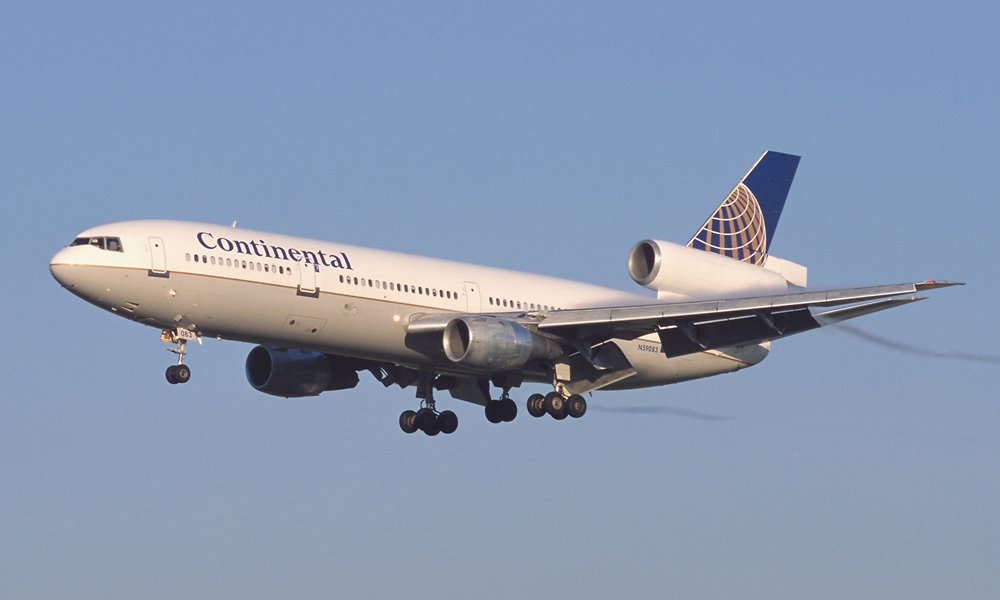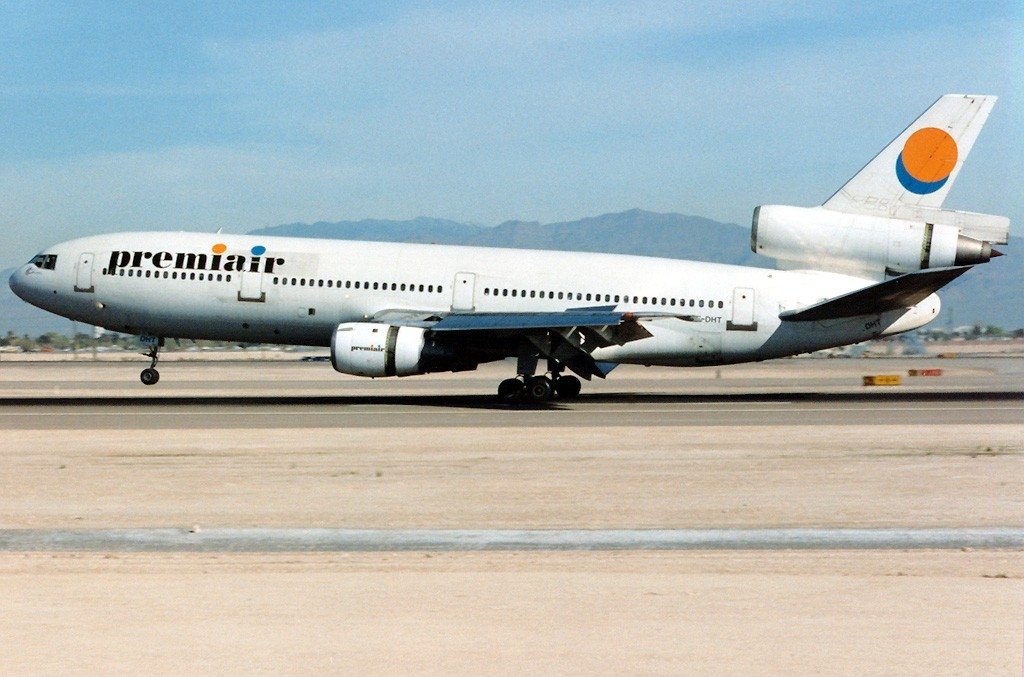
McDonnell-
Douglas
DC10.
SPECS
HISTORY
ORDERS
Omni Air International McDonnell Douglas DC10-30ER registration N522AX
Back in 1966, American Airliners let it be known to airliner manufacturers that they were looking for a larger passenger jet, but smaller than the Boeing 747.
The idea was to be able to fly into smaller airfields than the 747, but still, have the range of the larger aircraft. This would enable new markets to be opened up for widebody passenger transport.
In 1967, the same year the Douglas Aircraft Company and McDonnell Aircraft merged, the new company put forth an early design for a double-decker widebody aircraft with a passenger capacity of 550 passengers. It was to be the same length as the Douglas DC-8.
This was thrown out in favour of a widebody tri-jet with a capacity for 399 passengers, the length of a Douglas DC-8 Super 60.
Garuda Indonesian Airways McDonnell Douglas DC-10-30.
The new jet, designated the DC-10, was to be the replacement for the Douglas DC-8 on mid to long-haul routes and intercontinental routes. The design settled on three engines, one on each wing, and one at the base of the tail fin. The tail engine was a straight-through nacelle that was carried just above the fuselage, with the tail fin attached to the top. The horizontal stabilisers were affixed to the rear of the fuselage.
On 19 February 1968, American Airlines President, George A. Spater and James S. McDonnell of McDonnell Douglas announced the intention of American Airlines to go with the DC-10. This surprised Lockheed who was trying to bring their, quite similar, L1011 Tri-Star to market. American Airlines opted for the Rolls Royce RB211 engine and so the DC-10 project was launched.
SPECIFICATIONS
McDonnell Douglas DC-10 Specs Table
| DC-10 Specs | DC-10-10 | DC-10-30 | DC-10-40 | |
|---|---|---|---|---|
| Flight Crew |
3 | |||
| Range | 6,500km/3,500nm | 9,600km/5,200nm | 9,400km/5,100nm | |
| Standard Seating | 270 - 222 Economy / 48 Business | |||
| Fuselage Length | 55.55m/182ft 3.1in | 55.35m/181ft 7.2in | 55.54m/182ft 2.6in | |
| Max Width |
Cabin (internal) 5.69m/18ft 8in - Fuselage (external) 6.02m/19ft 9in | |||
| Wing Area |
330sq m / 3,550 sq ft | 338.8sq m / 3,647sq ft | ||
| Wing Span | 47.35m/155ft 4in | 50.39m/165ft 4in | ||
| Tail Height | 17.53m/57ft 6in | 17.55m/57ft 7in | ||
| Freight / Cargo Volume |
26 x LD3 | |||
| Cruise Speed | Typical Mach 0.82(473kn/876km/h) MMo Mach 0.88(507kn/940Km/h) | |||
| Max. Payload | 43,014kg/ 94,829lb | 46,180kg/101,809lb | 44,356kg/ 97,787lb | |
| Max. Take-off Weight | 195,045kg/430,000lb | 51,744kg/555,000lb | ||
| OEW | 108,940kg/240,171lb | 120,742kg/266,191lb | 122,567kg/270,213lb | |
| Maximum Payload | 43,014kg/ 94,829lb | 46,180kg/101,809lb | 44,356kg/ 97,787lb | |
| Fuel Capacity | 82,376L/21,762US Gal | 137,509L/36,652US Gal | ||
| Ceiling | 12,800 m (42,000 ft) | |||
| Engines x 3 | GE CF6-6D | GE CF6-50C | PW JT9D-59A | |
| Engine Thrust | 177.92 kN (40,000 lbf) | 226.85 kN (51,000 lbf) | 235.74 kN (53,000 lbf) | |
| Take-off | 2,700m/9,000ft | 3,200m/10,500ft | 2,900m/9,500ft | |
The February 1968 American Airlines order was for 25 aircraft which was followed shortly after by United Airlines in that year with an order for 30 airframes and an option for 30 more. The initial DC-10 variant was the DC-10-10 which was designed for the domestic market. It had a serviceable range of 6,100 kilometres/3,800 miles.
The maiden flight of the DC-10-10 took place on 29 August 1970. This started off with an intensive certification test program which consisted of 929 flights over 1,551 hours. The F.A.A. awarded the certification of the type on 29 July 1971.
American Airlines flew its first commercial DC-10 service on 05 August 1971 with a flight from Los Angeles to Chicago. United followed soon after with their own first service on 16 August 1971.
American had a slightly roomier configuration with 206 seats, against United's 222. Both airlines had a configuration of 6 seats abreast in first class and 8 seats in economy.
History.
United Airlines DC-10-10 registration N1806U.
The DC-10-10 was followed by the DC-10-15 which was, once again, designed for use in domestic services. This was known as a "hot and high" version of the DC-10-10 with more powerful engines and a few other modifications. This variant was capable of a useful range of 7,000 kilometres/4,350 miles.
Attention now turned to the international long-haul market. As intended by American Airlines' request for a smaller than 747 airliner, the DC-10 was well placed to fill the niche market of that mid-sized airliner. The Boeing 707 and the Douglas DC-8 were still active in that space but were becoming less attractive to passengers and accountants alike.
Jet engines had not yet evolved to the reliability we see today and long flights over water by twin-engine jets were still restricted by ETOPS - Extended-range Twin-engine Operational Performance Standards. (or Engines Turn Or Passengers Swim.) Even though Airbus was already working on a solution in the form of the Airbus A300, the American market was still firmly entrenched in the minimum of 3 engines for overwater flight ruling.
McDonnell Douglas DC-10-30 AOM French Airlines.
McDonnell Douglas proposed the DC-10-20 which was to be a much-improved version with a greater wingspan and additional fuel-carrying capacity. Northwest Orient Airlines, which was one of the launch customers of the type, requested that the designation be changed to DC-10-40. This was due to the aircraft being a substantially improved version over the DC-10-10 and DC-10-15 and Northwest Orient's president wanted to be seen to have the latest model. Northwest Orient and Japan Airlines were the only two airlines to order the type.
The most popular variant of the DC-10 was the DC-10-30. With 163 being produced, its production ran from 1972 to 1988.
The launch customers were K.L.M. Royal Dutch Airlines and Swissair who both received their first model on 21 November 1972. Swissair flew the first commercial service on 15 December 1972.
The DC-10-30 had a larger wingspan than the DC-10-10 which accommodated larger fuel tanks for a longer range. Due to the heavier operating weight of this aircraft, a two-wheeled bogie was added to the centre of the fuselage in line with the main underwing wheels. This served to support the extra weight as well spreading the weight on runways.
KLM DC-10-30 registration PH-DTD. Both KLM and Swissair were the launch customers for the most popular variant of the DC-10, the DC-10-30.
The DC-10 didn't get off to a great start.
It was seen to have a poor safety record as well as not being very economical.
In addition, Lockheed was introducing its L1011 Tri-Star which was very similar to the DC-10 in design. This penalised both manufacturers as they watered down the market by offering similar products.
The L1011 Tri-Star was probably a better aircraft but the DC-10 was cheaper to buy.
British Airways DC-10-30 registration G-NIUK.
The safety record, as mentioned above, was instrumental in soft sales to start with. One of the main culprits of the faulty design was the cargo door. On most aircraft, the cargo door opened inwards so that when closed, the door would be pushed into its seals by the higher inside pressure. The penalty of this design was a loss of space inside as the door had to be able to open inwards unimpeded.
The DC-10 on the other hand had an outward opening door. This allowed for that extra space to be utilised for storage, however, the outward pressure meant the door was totally reliant on its fastening mechanisms.
The mechanism consisted of a series of hooks that would fix over pegs which would lock in. The door-closing operator on the outside had no visual clue whether all the hooks had successfully engaged or not. There was an indicator needed next to the locking handle to signal it was locked as well as an indicator in the cockpit.
Biman Bangladesh Airlines DC-10-30 final flight at Birmingham (BHX) registration S2-ACR.
The full repercussions of what could go wrong were first felt on American Airlines flight AA96 on 12 June 1972. Out of Detroit and climbing through 11,750 feet over Windsor, Ontario, the pressure differential became such that the improperly closed cargo door blew out, causing explosive decompression.
The pressure differential between the depressurised cargo hold and the passenger cabin above then caused the cabin floor to partially collapse. The empennage surface controls, those for the rudder and horizontal stabilisers, ran under that floor and some were severed.
This reduced the pilot's ability to control the aircraft, but with the use of ailerons, partial rudder trim and asymmetrical use of engines the aircraft was landed and all 67 passengers walked away.
Delta McDonnell Douglas DC-10-10 registration N601DA at la Guardia (LGA) 04OCT73.
The NTSB (National Transportation Safety Board) made several recommendations, the main ones being that air vents be installed between the cargo hold and the passenger cabin to allow air pressure to equalise in the case of pressure loss so as to avoid a repeat of the cabin floor collapse.
Also, they recommended that the locking mechanism design be improved to prevent the ability of the closed indicator to show locked when it actually wasn't.
These recommendations were not mandated and a gentleman's agreement was reached between the heads of the FAA, John H. Shaffer, and McDonnell Douglas, Jackson McGowen.
McDonnell Douglas made modifications but the design remained unchanged.
McDonnell Douglas DC-10-30 LAM- Linhas Aereas de Mocambique.
On 03 March 1974, the self-same incident was repeated. Turkish Airlines flight 981 was climbing out of Paris when the improperly closed cargo door once again blew out.
This time the results led to one of the deadliest air accidents of the time. The flight controls were once again severed by the collapsing passenger cabin floor. The vents, to let air pressure equalise, had been installed but it was found they were too small to be effective. All 346 on board perished in a French forest.
Intense investigations were carried out and the resultant F.A.A. directives were given and carried out. The cargo door would not be a problem again.
Douglas DC-10-10 THY Turkish Airlines registration TC-JAU.
On 25 May 1979, a new nightmare started for McDonnell Douglas. American Airlines flight 191 was a DC-10-10 on a flight from Chicago, O'Hare International Airport to Los Angeles International Airport.
On its takeoff run at Chicago, witnesses said they noticed the left-hand engine bouncing up and down significantly. When the aircraft began to rotate for lift-off, that engine then separated from the wing and went up and over the wing to land on the runway behind. Its separation took a significant section of wing with it, including breaking several hydraulic lines.
The hydraulic lines that were cut caused the leading edge slats to retract which reduced the lift of that wing eventually causing it to stall. The aircraft then entered an uncontrolled left turn, reaching an altitude of 325 feet before rolling over and crashing at Des Plaines, Illinois.
With all 271 occupants perishing in the crash, this still remains the worst air crash in the U.S.A..
Air New Zealand McDonnell Douglas DC-10-30 (ZK-NZP) takes off at Sydney Airport. The pictured aircraft, registration ZK-NZP, was lost on 28 November 1979. Conducting a joy flight over Antarctica as flight NZ901 she flew into Mt. Erebus. 257 lives were lost.
The F.A.A. rescinded the type certification of all DC-10-10s on 06 June 1979 and grounded the type. This was a huge blow to McDonnell Douglas who worked quickly to make changes to the slat locking mechanism as well as modify power sources for those slats. The F.A.A. renewed certification on 13 July 1979.
The case of the separating pylon was traced back to non-standard procedures adopted by American Airlines and Continental Airlines.
The procedure called for the engine to be removed from the pylon and then that the pylon to be removed from the wing. To save almost 200 man hours, both airlines, when removing an engine, used a forklift to remove the whole assembly in one go. This was a very inexacting procedure as the forklift driver had to depend on the eyes of others as he could not see the join from where he sat. It was very easy to damage the assembly if it was not lined up perfectly. Both airlines were heavily fined.
Western Airlines DC10-30 registration N914WA.
There were other incidents and accidents but over time as the DC-10 started clocking up more safe flying hours, sales picked up again. As well as the passenger version, the type has also been extensively used as a mid-air refueling aircraft in the U.S. armed forces as well as enjoying popularity in the cargo field.
In December 1988 the last DC-10 rolled off the Long Beach production line and was delivered to Nigerian Airways in July 1989. This was the 446th aircraft and surpassed the 1971 estimate of 438 required to break even.
The DC-10 was succeeded by the MD-10 and then MD-11 which were slightly larger and updated models. In 1997, Boeing merged with McDonnell Douglas and updated the MD-11 to have a glass cockpit which eliminated the need for a flight engineer.
Japan Airlines DC10-40 registration JA8549.
In February 2014 the last passenger flight of a DC-10 was conducted. Cargo airlines, like FedEx Express which is the largest operator, still fly the type.
The DC-10 was a popular aircraft, liked by pilots and passengers alike. There was a great feeling of space in the cabin with high ceilings. Most airline configurations had two seats at the window which made it very attractive, as you were never more than one seat from an aisle.
Premiair McDonnell Douglas DC-10-10 registration SE-DHT
Orders and Deliveries.
| DC10 | Orders | Deliveries |
|---|---|---|
| Aeromexico | 6 | 4 |
| Air Afrique | 4 | 3 |
| Air Atlantis | 2 | 0 |
| Air New Zealand | 8 | 8 |
| Air Serbia | 2 | 2 |
| Air Siam | 1 | 1 |
| Alitalia | 14 | 8 |
| American Airlines | 35 | 35 |
| Ariana Afghan Airlines | 1 | 1 |
| ATAircraft One | 5 | 4 |
| Balair/CTA | 2 | 1 |
| Biman Bangladesh Airlines | 1 | 1 |
| British Caledonian Airways | 8 | 8 |
| China Airlines | 2 | 0 |
| Condor Flugdienst | 3 | 3 |
| CP Air | 7 | 7 |
| EgyptAir | 4 | 0 |
| FedEx Express | 11 | 11 |
| Finnair | 3 | 3 |
| Garuda Indonesia | 6 | 6 |
| Ghana Airways | 2 | 1 |
| Iberia Airlines | 9 | 9 |
| Japan Airlines | 20 | 20 |
| Japan Airlines Co., Ltd. | 2 | 2 |
| KLM Royal Dutch Airlines | 11 | 11 |
| Korean Air | 5 | 3 |
| DC10(Contd.) | Orders | Deliveries |
|---|---|---|
| Laker Airways (Bahamas) | 11 | 11 |
| Lignes Aeriennes de Congolaise | 2 | 2 |
| Lufthansa | 11 | 11 |
| Malaysia Airlines | 3 | 3 |
| Martinair Cargo | 4 | 4 |
| Mexicana | 7 | 5 |
| National Airlines | 19 | 16 |
| Nigeria Airways | 3 | 3 |
| Northwest-Merged w Delta | 22 | 22 |
| Pakistan International Airline | 4 | 4 |
| Philippine Airlines | 2 | 2 |
| SABENA Aerospace | 5 | 5 |
| Scandinavian Airlines | 5 | 5 |
| Seaboard World Airlines | 1 | 1 |
| Singapore Airlines | 7 | 7 |
| Swissair | 13 | 13 |
| Thai Airways International | 5 | 5 |
| Transamerica Airlines | 3 | 3 |
| Turkish Airlines | 3 | 3 |
| U.S. Air Force | 60 | 60 |
| United Airlines | 73 | 65 |
| UTA | 8 | 6 |
| Varig Airlines | 10 | 10 |
| VIASA | 4 | 3 |
| Wardair | 2 | 2 |
| Western Airlines | 15 | 13 |
| World Airways, Inc. | 9 | 9 |
| Zambia Airways | 2 | 1 |
| Grand Total | 487 | 446 |



















